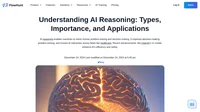AI Explainability refers to the ability to understand and interpret the decisions and predictions made by artificial intelligence (AI) systems. As AI and machine learning algorithms become increasingly complex, especially with the advent of deep learning and neural networks, they often operate as “black boxes.” This means that even the engineers and data scientists who develop these models may not fully comprehend how specific inputs lead to specific outputs. AI Explainability seeks to shed light on these processes, making AI systems more transparent and their outcomes more understandable to humans.
Why is AI Explainability Important?
Trust and Transparency
For AI systems to be widely accepted and trusted, especially in critical domains like healthcare, finance, and legal systems, stakeholders need to understand how decisions are made. When a machine learning algorithm recommends a medical treatment or approves a loan application, it’s crucial for users to know the rationale behind these decisions to ensure fairness and to build trust.
Regulatory Requirements
Many industries are subject to regulatory frameworks that require transparency in decision-making processes. Regulations may mandate that organizations provide explanations for automated decisions, especially when they significantly impact individuals. Failure to comply can result in legal repercussions and loss of consumer trust.
Identifying and Mitigating Bias
AI systems trained on biased data can perpetuate and even amplify those biases. Explainability allows developers and stakeholders to identify unfair or biased decision-making within AI models. By understanding how decisions are made, organizations can take steps to correct biases, ensuring that the AI systems operate fairly across different demographics.
Improving Model Performance
Understanding the inner workings of AI models enables data scientists to optimize model performance. By interpreting which features influence decisions, they can fine-tune the model, improve accuracy, and ensure it generalizes well to new data.
How is AI Explainability Achieved?
Achieving AI Explainability involves a combination of designing interpretable models and applying techniques to interpret complex models post hoc.
Interpretability vs. Explainability
- Interpretability refers to the extent to which a human can understand the cause of a decision made by an AI system.
- Explainability goes a step further by providing an explicit description of the factors and reasoning that led to a decision.
While both concepts are related, interpretability focuses on the transparency of the model itself, whereas explainability focuses on generating explanations for the model’s output.
Interpretable Models
Interpretable models are inherently understandable. Examples include:
- Linear Regression: Models where the relationship between input features and the output is linear, making it straightforward to interpret coefficients as the influence of each feature.
- Decision Trees: Visual representations of decisions, where each node represents a feature, and branches represent decision rules.
- Rule-Based Systems: Systems that use a set of human-understandable rules to make decisions.
These models sacrifice some predictive power for transparency but are valuable when explainability is crucial.
Post-Hoc Explanations
For complex models like deep neural networks, which are less interpretable, post-hoc explanations are used. These techniques analyze the model’s behavior after it has made a prediction.
Model-Agnostic Methods
These methods can be applied to any type of model without requiring access to its internal structure.
Local Interpretable Model-Agnostic Explanations (LIME)
LIME is a popular technique that explains the prediction of any classifier by approximating it locally with an interpretable model. For a given prediction, LIME perturbs the input data slightly and observes changes in the output to determine which features influence the decision the most.
SHapley Additive exPlanations (SHAP)
SHAP values are based on cooperative game theory and provide a unified measure of feature importance. They quantify the contribution of each feature to the prediction, considering all possible combinations of features.
Global vs. Local Explanations
- Global Explanations: Provide an overall understanding of the model’s behavior across all data points.
- Local Explanations: Focus on a single prediction, explaining why the model made a specific decision for an individual instance.
Research on AI Explainability
AI explainability has garnered significant attention as AI systems become more integrated into human decision-making processes. Here are some recent scientific papers that delve into this crucial topic:
- Explainable AI Improves Task Performance in Human-AI Collaboration (Published: 2024-06-12)
Authors: Julian Senoner, Simon Schallmoser, Bernhard Kratzwald, Stefan Feuerriegel, Torbjørn Netland
This paper explores the impact of explainable AI in enhancing task performance during human-AI collaboration. The authors argue that traditional AI operates as a black-box, making it difficult for humans to validate AI predictions against their own knowledge. By introducing explainable AI, specifically through visual heatmaps, the study found improved task performance. Two experiments were conducted involving factory workers and radiologists, demonstrating a significant reduction in error rates when using explainable AI. This research underscores the potential of explainable AI in improving decision-making accuracy in real-world tasks. Read more - “Weak AI” is Likely to Never Become “Strong AI”, So What is its Greatest Value for Us? (Published: 2021-03-29)
Author: Bin Liu
This paper addresses the ongoing controversies surrounding AI’s capabilities and future potential. It differentiates between “weak AI” and “strong AI” and argues that while strong AI may not be achievable, weak AI holds substantial value. The author delves into the criteria for classifying AI research and discusses the societal implications of AI’s current capabilities. This work provides a philosophical perspective on the role of AI in society. Read more - Understanding Mental Models of AI through Player-AI Interaction (Published: 2021-03-30)
Authors: Jennifer Villareale, Jichen Zhu
This study investigates how individuals develop mental models of AI systems through interactions in AI-based games. The authors propose that these interactions offer valuable insights into the evolving mental models of AI users. A case study is presented to highlight the advantages of using games to study explainable AI, suggesting that such interactions can enhance user understanding of AI systems. Read more - From Explainable to Interactive AI: A Literature Review on Current Trends in Human-AI Interaction (Published: 2024-05-23)
Authors: Muhammad Raees, Inge Meijerink, Ioanna Lykourentzou, Vassilis-Javed Khan, Konstantinos Papangelis
This literature review examines the transition from explainable AI to interactive AI, emphasizing the importance of human involvement in AI system development and operation. The paper reviews current trends and societal concerns regarding human-AI interaction, highlighting the need for AI systems that are both explainable and interactive. This comprehensive review provides a roadmap for future research in the field. Read more
Data-backed Content With No Fluff
Create data-driven content with FlowHunt’s AI tools. From idea generation to editing, streamline your process for engaging, SEO-optimized results!
Understanding AI Reasoning: Types, Importance, and Applications
Explore AI reasoning types, importance, and applications in healthcare and beyond. Discover how AI enhances decision-making and innovation.



